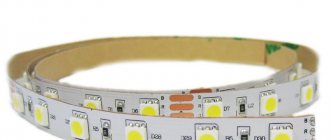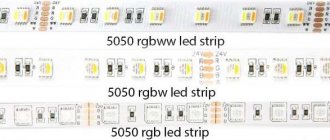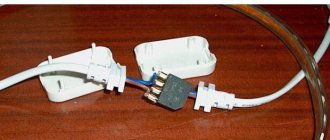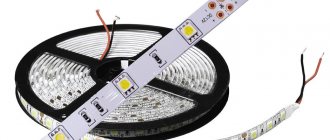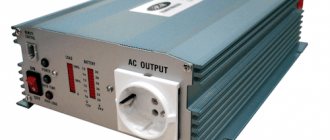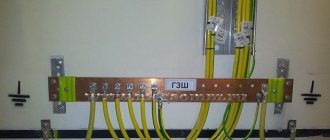01/16/2017 master
Many people today do their own tuning of their vehicles. Lighting tuning organized using LED strips is quite popular among car enthusiasts.
Car illumination with LED strip
Using this product as a backlight, you need to know how to connect an LED strip to a car. But here difficulties can arise not only with installation, but also with the choice of product. Our article will tell you how to do everything correctly and ultimately get high-quality and beautiful lighting.
Why LED strip?
Today, a car's lighting system can be organized using various lighting devices. But many car enthusiasts prefer to illuminate their iron horses with LED strips. The reason for such popularity lies in its advantages:
- A fairly simple installation that can be easily done with your own hands, which is very important for people who like to tinker with the car in their free time. Installation here does not require professional knowledge of an electrician. Anyone who follows the step-by-step instructions given below can install such a tape;
- such a backlight can glow in different colors (blue, green, yellow, purple, etc.). This allows you not only to make the lighting of the interior or exterior of the car high-quality, but also to set off the color of the body;
External car tuning
- the LED strip creates a high-quality and fairly bright luminous flux, which perfectly illuminates the interior elements or the road surface;
- long period of product operation;
- minimal energy consumption;
Note! Led can have a voltage of 12 and 24 volts. To illuminate a car, a product with a voltage of 12 volts is most often used.
- high resistance of LEDs to vibration and various types of mechanical stress. This is especially important for a car that constantly vibrates while driving on the roads;
- environmental friendliness. All components are made from environmentally friendly materials and do not contain toxic or poisonous components. Therefore, such lighting can be safely installed in the cabin even in situations where children are frequently transported.
Despite this, the LED strip has certain operating and connection features:
- due to the fact that such products have a voltage of 12 volts, you will need to follow specific installation instructions;
Appearance of LED strip
- You need to cut only in strictly defined places. They are placed with a black dotted line and a scissors icon;
- Due to the wide variety of LED products of this type, it is not always possible to choose the optimal model option.
In addition, such lighting products are not very cheap. Although, if only the interior (dashboard) or headlights of the car are illuminated, then installation costs will be insignificant. It will cost much more to install lighting tuning on the outside around the entire perimeter of the car.
Choosing a belt for the machine
I will try not to pour water, but will briefly look at what to look for when choosing an LED strip.
LED Matrix Type
LED interior lighting . To illuminate the car interior, including the trunk, choose SMD 3528 60pcs/m (the size of one LED crystal is 3.5x2.8mm). Why she?
Firstly, we get an average power of 4.4-4.8 W per linear meter with a luminous flux of about 250-300 Lm. With such power, LEDs do not require heat dissipation and the LED strip can be easily mounted on plastic elements. And the luminous flux is sufficient to fully illuminate any interior elements.
If you don’t have enough brightness, take 120 pcs/m.
Secondly, this is the most common tape on sale, we buy it in the first store we come across.
Options like SMD 5050, 5630, 5730 are not suitable due to their high power. Unpleasantly high brightness and the need to mount a heat sink make them not the best choice for LED car interior lighting.
Exterior car lighting . Here we turn on the head. If there is LED lighting under the bottom of the car, you can choose more powerful LEDs - SMD 5050 30/60 pcs/m. The aluminum profile will be our heat sink (more about installation later). For LED illumination of license plates or (God forbid) headlights, this is a bad choice. Such LED lighting will be a bait for traffic police inspectors (read about installation rules and fines at the end of the article).
Regular LEDs or RGB - there is no difference. RGB is a little more expensive, it is more difficult to connect and requires an additional control controller (read more about connecting an RGB strip). But it allows you to change the backlight color.
Protection class
There are mainly three protection classes on sale - IP20, IP65, IP68.
- IP20 – open tape without protective coatings, suitable for use indoors in dry rooms. Afraid of moisture, dust, and any mechanical influences.
- IP65 – with a protective silicone layer that can protect against condensation.
- IP68 - sealed, waterproof LEDs that can be placed on the bottom of the car.
For LED illumination of the glove compartment or the bottom of the dashboard, IP20 is also suitable if no one pulls it or pours water on it.
For illumination of other elements, IP class 65-68 is desirable.
Where can I place the ribbon?
An LED strip with a voltage of 12 volts (as well as 24 volt models) can be used as illumination for any vehicle for several purposes:
- interior dashboard lighting. This kind of interior lighting is very common, since using an LED strip you can illuminate any area of the dashboard well. What products should be chosen for interior lighting will be discussed in the next section;
LED instrument panel lighting
- You can install an LED strip in your car headlights yourself. Popularly this type of tuning is called “angel eyes”. Here you need to use either separate LEDs, or simply run a strip around the headlight. In this case, LEDs can occupy different locations in the headlight. In this case, it is possible to increase the lighting capabilities of the headlights several times, due to which they will begin to refresh the roadway much better in the evening and night hours;
Note! Many foreign car models are often already equipped with angel eyes tuning. But for cars of the domestic auto industry they are made with their own hands.
Tuning "angel eyes"
- full tuning of the car body. In this case, the 12 volt tape will be installed at the bottom of the body. As a result, the car will be illuminated from below, which will create the effect of “floating”.
Body tuning
Any type of lighting can be done independently. The main thing here is the correct connection of the lighting product. In this case, the connection for all options will be carried out almost identically. In order for your homemade car lighting, implemented using a 12-volt LED strip, to work for a long time and with high quality, you need to choose the right light source.
Precautionary measures
- LED strip breaks very easily, but it is difficult to notice: the wires inside the strip break, although outwardly it remains intact. Hence the rule: when installing the tape, you should not bend it too much. The bending radius should not exceed 7 cm;
- Before connecting the tape to the vehicle's on-board network, you must remove the negative terminal from the battery;
- LEDs are semiconductor devices that operate on direct current. Therefore, when connecting the tape, it is extremely important to maintain polarity;
- In any, even the simplest tape connection scheme, a voltage stabilizer must be provided. Without it, the service life of even the highest quality tape will be very short. It is not necessary that this be a 7812 circuit. Almost any stabilizer for a 12 volt network, which can be purchased at any radio parts store, is suitable;
- the aluminum radiator with the stabilizer attached to it must be carefully isolated from the car body.
Connecting an LED strip to a car is not a difficult task. It is quite feasible even for a novice car enthusiast who has at least a superficial understanding of electrical engineering. The main thing is not to make a mistake with the polarity when assembling the circuit and not to neglect the stabilizers, no matter how stable the on-board network of the machine may seem.
Setting up a Pioneer radio in your car
How to connect a DVR in a car without using a cigarette lighter or wires
Making the right choice
Today, models with LEDs designed for 12 volts are specially sold on the market. They are offered in a wide range and in order to choose the most suitable model for your car, you need to rely on the following selection criteria:
- placement location. As we have already found out, such lighting can be installed inside the cabin on the dashboard, in the headlight and outside the body. In all three cases, the conditions under which the device operates will differ, which must be taken into account when choosing;
- what type of glow should there be;
Note! To illuminate the car interior and for external tuning, you can use strips that produce a color luminous flux (red, blue, etc.), but the headlights need to be connected to light sources with a white or yellow glow.
Light from LED headlights
- product power;
- degree of protection against moisture. Naturally, lighting for the car interior and headlights should be organized using standard products with a not too high level of moisture protection. At the same time, only waterproof 12-volt models can be used for outdoor lighting.
In order to make exactly the right choice and quickly install the LED strip in your car with your own hands, you need to have an idea of its range.
Legality of outdoor lighting and fines
In our country, laws are interpreted in favor of the interpreter. The wording is vague and can be interpreted in two ways. What you need to know.
There is no direct ban on installing underbody lighting . But there are a number of points that allow us to find fault with you and, unfortunately, there is nothing to oppose them with.
Making unforeseen changes to the vehicle design
Decree of the Government of the Russian Federation of October 23, 1993 N 1090 (as amended on August 27, 2018) “On the Rules of the Road.” Appendix: List of faults and conditions under which the operation of vehicles is prohibited. Clause 7.18.
Changes were made to the design of the vehicle without permission from the State Road Safety Inspectorate of the Ministry of Internal Affairs of the Russian Federation.
It is impossible to obtain official permission to install lighting (uncertified element). Punishment for violation: warning or fine of 500 rubles .
This is the most loyal point on which they can find fault with you. You will often get off with a warning.
Violation of the rules for installing lighting devices
You will fall under this clause if you install LED car lighting in prohibited colors.
According to the Russian Federation Traffic Regulations, section 3.6. External lighting devices. Installation is prohibited:
In front - lighting devices with lights of any color except white, yellow or orange; At the rear - reverse lights and license plate lights with lights of any color other than white, and other lighting devices with lights of any color other than red, yellow or orange.
In short, the following is allowed:
- The front is just white, yellow and orange;
- at the rear - the license plate is illuminated only in white, the rest - only in red, yellow or orange.
Violation of this clause of the traffic rules entails deprivation of a driver's license for a period of 6 months to a year .
Installation without permission of devices for supplying special light signals
Code of Administrative Offenses of the Russian Federation Article 12.5. Driving a vehicle in the presence of malfunctions... point 4.
Driving a vehicle on which, without appropriate permission, devices are installed to provide special light or sound signals (with the exception of a security alarm).
This is the most dangerous point and, if the evil inspector wishes, any additional lighting of the car can be adjusted to this wording. In practice, it is used very rarely (unless you put a red flashing tape in the radiator, this option will definitely be regarded as a special signal). It is difficult to challenge in court, but it is possible by replacing the punishment with a fine of 500 rubles.
Violation provides for deprivation of rights for a period of one to one and a half years , with confiscation of devices for signaling.
Please rate the article. We tried our best:)
Did you like the article? Tell us about her! You will help us a lot :)
Nuances of choice
LED products for cars are mainly represented by single-color 12-volt models. This makes it much easier to choose a color to match the body. It is best to choose products that have a self-adhesive backing. This greatly simplifies installation, as well as do-it-yourself connections. Such products can easily be installed on the dashboard of a car.
Self-adhesive tape
In addition, these products are divided into two groups according to the type of LEDs:
- SMD 3028 - LEDs have dimensions of 3 by 2.8 millimeters;
- SMD 5050 - LEDs have dimensions of 5 millimeters.
Another important connection point that plays a role in calculating the total power of the strip is the density of LEDs per meter.
Note! Often sellers say the density for the entire tape (5 meters in a skein), and not for one meter. An incorrectly specified density parameter can lead to serious problems during the operation of the backlight.
For SMD 3028 the density can be 60, 120 or 240 LEDs, and for SMD 5050 - with 30, 60, 120 LEDs per meter. Remember that the higher the density, the brighter the 12 volt LED strip will shine. Another point in installing this product is the correct calculation of the product’s power. Since the tape can be cut into pieces of almost any length (the minimum cutting pitch is the distance between two adjacent contact pads), this parameter will vary. To calculate power you need to use a special formula.
Contact pads on the tape
Since the tape has a voltage of 12 volts, a power supply is required to connect it. We select it based on the power obtained during mathematical calculations and add 20% of the reserve. The last aspect of the choice will be the determination of the moisture resistance class. This indicator is referred to as IP. Today there are three classes of water resistance for vehicles:
- 20 – tape without insulation, so it can only be installed inside the car on the dashboard;
- 65 – the product is protected from moisture and can be used under a canopy. Such products are best installed in headlights;
- 68 – tape of a fully insulated type. It can be safely installed under the car body, where it can be in contact with water and dirt for a long time without any problems.
Based on the selection parameters listed above, you can choose an LED strip for any occasion without any problems.
Species and types
Products can be classified according to various criteria: by the size of the LEDs and their density, voltage consumption, glow colors, and even the degree of protection from dust and moisture. Let's look at each type in more detail.
LED Size
Modern LEDs for cars are labeled SMD, which stands for Surface Mounted Device. Translated from English, this means “a device that is mounted on a surface.” Next to the abbreviation is a number indicating the aspect ratio. The most commonly available LED sizes are:
- SMD3528 - diode parameters 3.5 by 2.8 mm;
- SMD3010 - diode parameters 3 by 1 mm;
- SMD5050 - diode parameters 5 by 5 mm.
The numbers in the LED labeling indicate their parameters
LED Density
A little earlier we talked about the design of the LED strip, mentioning the fact that there are usually 30 elements per 1 m of substrate. This option is the most common, as it has optimal brightness. Products with denser diodes may distract the driver if they are located inside the vehicle. But for exterior decoration, you can choose any of the types you like.
Please note that as the number of elements increases, the total voltage of the tape increases in direct proportion.
- 30 SMD5050 diodes per 1 m - 7.2 W;
- 60 SMD5050 diodes per 1 m - 14.4 W;
- 120 SMD5050 diodes per 1 m - 28.8 W;
- 240 SMD5050 diodes per 1 m - 57.6 W.
Moreover, the latter type, as a rule, has two rows of diodes and is powered by a voltage of 24 V.
LEDs can be arranged in 30, 60, 120 and 240 pieces per meter
Glow colors
Everything is simple here: diodes can be white, with both cold and warm light temperatures (in this case, the warmest color becomes yellow), as well as blue, green and red. Moreover, the tapes can be one constant color, or they can change them, remaining in the RGB spectrum.
Ribbons can have a constant color, or they can change them
Dust and moisture protection
Despite its small size, the LED strip is still an electrical device, which means it can be negatively affected by excessive humidity, as well as dust and moisture. At the same time, tapes are produced with varying degrees of security, which are designated by the abbreviation IP and have a numerical designation.
- IP20 is the most unprotected type of device, which can only be used in favorable conditions;
- IP65 - medium level of protection tape, coated with a thin layer of epoxy resin;
- IP68 is the best degree of device protection, which ensures uninterrupted use even in the most adverse conditions.
Protection in the latter type is provided by a dense silicone shell. Thanks to it, such a tape can be used to decorate elements of the body, bumper, and even car rims: it is not afraid of dirt and water. But the first type can be used exclusively inside the cabin, and even then not in every place. The second type is optimal in terms of degree of protection, conditions of use and price.
Tapes can be open or protected
Video: overview of different types of tapes
Installation option without interfering with the electrical network
You can install and connect LED lighting in your car yourself without interfering with the vehicle’s electrical network. Let's look at this method using the example of connecting a waterproof RGB strip to four contacts. Here you will need:
- four connectors or terminals;
- controller designed for 12 volts (for passenger cars). It is installed to make it possible to control the backlight;
- stranded wire. It should have the same colors as the controller;
- silicone sealant.
The installation process will be discussed using the example of installing the tape under the dashboard inside the cabin. All subsequent actions look like this:
- The tape is cut into the required fragments and then soldered using a soldering iron. You can also use connectors for connections, this method will be many times more expensive;
Tape soldering process
- then all places that have been soldered should be treated with silicone glue;
- we install the tape where it should be to illuminate the required area;
- all wiring must be carefully soldered and then hidden under the skin of the car;
- the ends of the tape should be connected to the controller. To do this, you can follow the following diagram;
Controller connection diagram
- To connect a lighting product to the cigarette lighter, you can simply upgrade your car charger for your mobile phone. To do this, one of its wires needs to be soldered to the fuse, and the second to the right metal ear. As a result, the stabilizer will be bypassed. After that, close the charging case and insert it into the controller;
- Then we insert the charger into the car's cigarette lighter.
Note! This type of backlight will only work when the engine is running or the ignition key is turned on.
Ready backlight
Now you can control the light and music using the remote control.
Safety precautions during installation and operation
When installing, connecting and further using strips with LEDs, follow the following safety rules.
- The first and most important rule is to disconnect the battery before starting any electrical work. This also applies to the installation of tapes.
- Choose the type of tape depending on the mounting location: an open and unprotected IP20 tape will fail if it is placed on the car body. And tapes with a dense arrangement of large diodes can blind the driver inside the cabin.
- Do not bend the tapes too much as this may damage the internal wiring.
- Use a soldering iron with low power only.
- The length of the tape section should not exceed 5 meters. If you need to connect several such sections, you need to do it in parallel.
- Pay close attention to the polarity of the contacts. Pros and cons should be in their place. Experts say that this tape can survive a one-time incorrect connection, but it’s still not worth checking this fact. Be careful.
- It will be useful to install voltage stabilizers so that no more than 12 V is supplied to the device.
- If you use a separate power supply, its power reserve should be at least 20%.
- When laying on a metal surface, it is recommended to make an insulating gasket.
- If you made holes in the car body for fastening or installing wiring, be sure to treat them with a composition that prevents corrosion.
- Before turning on the battery, double-check that the wiring is installed correctly.
Second installation method
This method can be used by installing lighting in the interior, trunk and under the hood. Here you will need:
- LED strip with two contacts;
- wire having two different colored wires. The red one will be soldered to its “plus”, and the black one to the “minus” of the tape.
The preparation of the lighting device follows the same principle as in the first method. After installing the product, we perform the following manipulations:
- connect the black wire to the battery (to the negative terminal);
- We attach the red one to the toggle switch, and then connect it to the positive terminal of the battery;
Diagram of connecting wires to the battery
- Then in the cabin we install the toggle switch in a place convenient for you.
That's all.
Ready backlight
If the product does not light up with this connection, then you need to check that the polarity of the wires is correct.
Connect to headlights
The LED strip can be installed on top of the headlight. This method does not require removing the headlight, but it is worth considering the disadvantages of application: not very beautiful design, contamination of the element, accumulation of snow, ice buildup.
For work you will need moisture-resistant tape. It is attached to the headlight with an adhesive base. Connection work is underway. This procedure will take no more than 10 minutes.
The process of connecting under the headlights is labor-intensive. In addition, you need to remove the headlight and depressurize it. After gluing, sealing is carried out again. Otherwise, moisture will pass under the headlight glass.
With this method, the lighting looks very beautiful.
View this post on Instagram
Posted by ak_garaj_semey (@ak_garaj_semey) Nov 19, 2022 at 10:07 PST
Installation Rules
When starting installation and connecting the LED strip, you need to know and remember the following rules:
- diodes can be connected either from a resistor (power supply) or from a cigarette lighter;
- The tape can only be cut in strictly designated areas;
Tape cut location
- The length of the backlight must be determined before starting the connection. In this case, all pieces of the product must be soldered into a single electrical circuit;
- Do not bend the tape too much. If it is bent with a radius of less than 80 mm, the conductive layer of the flexible board may rupture;
- Some wiring diagrams for this product may contain a voltage stabilizer. It will make it possible to create a voltage of the required 12 volts;
- installation is carried out only with the negative terminal disconnected from the battery.
Follow these rules and everything will turn out well for you.
Material and tools
LED strip for cars is installed using the following materials and tools:
- LED strip. There is no need to buy cheap options, as they break quickly. If you want to constantly change the color, then you need to buy an RGB tape. But to switch colors you will need a controller.
- To cut the desired length you will need scissors.
- To connect, you will need a cable.
- For soldering, soldering iron, rosin, solder.
- Power unit. It must be suitable in terms of power and type of tape. Needed to protect the battery from discharge.
- Connectors (if you decide to connect with them). For reliability, it is worth buying permanent connectors, not “crocodiles”. They should be screwed in with a screwdriver, ensuring full contact.
Connection options
It's time to familiarize yourself with the main connection options.
To one resistor
Typical connection diagram.
As we already found out above, the LED has polarity. Therefore, it is connected to a DC power source. The most common types consume about 10-20 mA. In fact, this is the main characteristic of the part. The second parameter indicates the voltage drop. For conventional LEDs it is in the range of 2-4 V.
The only correct connection diagram is with a current-limiting resistor. It is selected according to Ohm's law. Resistance is calculated as the difference between the source voltage and the voltage drop divided by the product of the maximum diode current and the safety factor (usually 0.75).
It is also necessary to calculate the power of the resistor. It is calculated using a simple formula: the difference between the source voltage and the voltage drop squared, divided by the resistance in ohms.
Daisy chain connection of several LEDs
Schematic diagram of serial connection.
Serial connection is the installation of two or more LEDs in one row. This circuit also uses one current-limiting resistor. The calculation formula is similar for a single diode, but the voltage drop is summed up.
For example, let's take our theoretical white LED of 3 volts and 20 mA. We connect three units in series. Thus, the sum of our voltage drop will be 9 volts. We divide the remainder of three volts by a current of 0.02 amperes with a safety factor of 0.75. As a result, we find out that we need one 200 Ohm resistor.
Each diode to a separate resistor
Schematic diagram of parallel connection.
In this circuit, each LED is connected to the plus and minus of the power source. Despite the fact that you can find circuits with one common resistor on the Internet, in practice such a solution is impractical. Even within the same batch, diodes differ in terms of current consumption and voltage drop. As a result, we will get different glow intensities of the diodes. Resistance is calculated for each diode separately.
Calculation of LED connections in 12 and 220 volt circuits
A separate LED cannot be connected directly to a 12V power source because it will burn out immediately. It is necessary to use a limiting resistor, the parameters of which are calculated using the formula: R= (Upit-Upad)/0.75I, in which R is the resistance of the resistor, Upit and Upad are the supply and drop voltages, I is the current passing through the circuit, 0.75 – LED reliability coefficient, which is a constant value.
As an example, we can take the circuit used to connect 12-volt LEDs in a car to a battery. The initial data will look like this:
- Upit = 12V – voltage in the car battery;
- Upad = 2.2V – LED supply voltage;
- I = 10 mA or 0.01A – current of a separate LED.
According to the formula above, the resistance value will be as follows: R = (12 – 2.2)/0.75 x 0.01 = 1306 ohms or 1.306 kohms. Thus, the closest would be a standard resistor value of 1.3 kOhm. In addition, you will need to calculate the minimum resistor power. These calculations are also used when deciding how to connect a powerful LED to 12 volts there. The actual current value is preliminarily determined, which may not coincide with the value indicated above. For this, another formula is used: I = U / (Rres. + Rlight), in which Rlight is the resistance of the LED and is defined as Up.nom. / Inom. = 2.2 / 0.01 = 220 Ohm. Therefore, the current in the circuit will be: I = 12 / (1300 + 220) = 0.007 A.
As a result, the actual voltage drop of the LED will be equal to: Udrop.light = Rlight x I = 220 x 0.007 = 1.54 V. The final power value will look like this: P = (Usupply - Udrop)² / R = (12 - 1.54)²/ 1300 = 0.0841 W). For practical connection, it is recommended to increase the power value slightly, for example to 0.125 W. Thanks to these calculations, it is possible to easily connect an LED to a 12 volt battery. Thus, to properly connect one LED to a 12V car battery, you will additionally need a 1.3 kOhm resistor in the circuit, the power of which is 0.125 W, connecting to any contact of the LED .
The calculation of connecting an LED to a 220V network is carried out according to the same scheme as for 12V. As an example, we take the same LED with a current of 10 mA and a voltage of 2.2V. Since the network uses alternating current with a voltage of 220V, the calculation of the resistor will look like this: R = (Up.-Up.) / (I x 0.75). By inserting all the necessary data into the formula, we get the real resistance value: R = (220 - 2.2) / (0.01 x 0.75) = 29040 Ohm or 29.040 kOhm. The closest standard resistor value is 30 kOhm.
Next, the power calculation is performed. First, the value of the actual consumption current is determined: I = U / (Rres. + Rlight). The LED resistance is calculated by the formula: Rlight = Up.nom. / Inom. = 2.2 / 0.01 = 220 Ohm. Therefore, the current in the electrical circuit will be: I = 220 / (30000 + 220) = 0.007A. As a result, the actual voltage drop across the LED will be as follows: Udrop.light = Rlight x I = 220 x 0.007 = 1.54V.
To determine the power of the resistor, the formula is used: P = (Upit. - Upad.)² / R = (220 -1.54)² / 30000 = 1.59 W. The power value should be increased to the standard 2W. Thus, to connect one LED to a network with a voltage of 220V, you will need a 30 kOhm resistor with a power of 2W.
However, alternating current flows in the network and the light bulb will burn in only one half-phase. The light will flash quickly at 25 flashes per second. For the human eye, this is completely invisible and is perceived as a constant glow. In such a situation, reverse breakdowns are possible, which can lead to premature failure of the light source. To avoid this, a reverse directional diode is installed to ensure balance in the entire network.
Turning on the LEDs from the power supply
We will talk about power supplies (PSUs) operating from a 220 V AC network. But even they can differ greatly in output parameters. It can be:
- AC voltage sources, inside of which there is only a step-down transformer;
- unstabilized direct voltage sources (DCS);
- stabilized PPI;
- stabilized direct current sources (LED drivers).
You can connect an LED to any of them by adding the necessary radio elements to the circuit. Most often, stabilized power supply voltages of 5 V or 12 V are used as a power supply. This type of power supply means that in the event of possible fluctuations in the network voltage, as well as when the load current changes within a given range, the output voltage will not change. This advantage allows you to connect LEDs to the power supply using only resistors. And it is precisely this connection principle that is implemented in circuits with indicator LEDs.
LED matrices
- Idriver – driver current according to the passport, A;
- ILED – rated current of the LED, A.
You can even use one 1.5 V AA battery as a power source. But to do this, you will have to assemble a small electrical circuit that will increase the supply voltage to the required level. You can learn how to do this in the article “How to connect an LED from a 1.5 V battery.”

